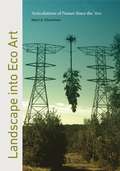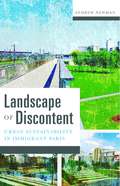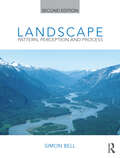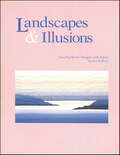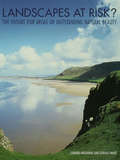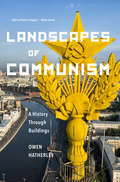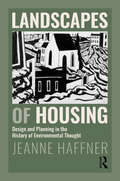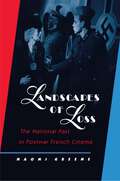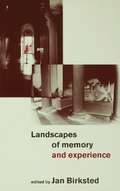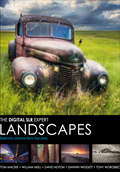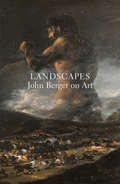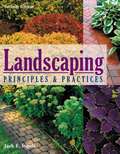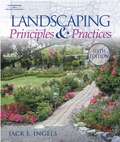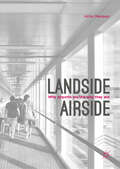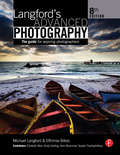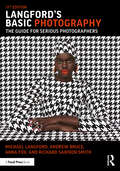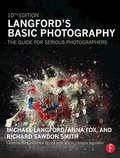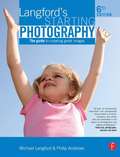- Table View
- List View
Landscape into Eco Art: Articulations of Nature Since the ’60s
by Mark CheethamDedicated to an articulation of the earth from broadly ecological perspectives, eco art is a vibrant subset of contemporary art that addresses the widespread public concern with rapid climate change and related environmental issues. In Landscape into Eco Art, Mark Cheetham systematically examines connections and divergences between contemporary eco art, land art of the 1960s and 1970s, and the historical genre of landscape painting.Through eight thematic case studies that illuminate what eco art means in practice, reception, and history, Cheetham places the form in a longer and broader art-historical context. He considers a wide range of media—from painting, sculpture, and photography to artists’ films, video, sound work, animation, and installation—and analyzes the work of internationally prominent artists such as Olafur Eliasson, Nancy Holt, Mark Dion, and Robert Smithson. In doing so, Cheetham reveals eco art to be a dynamic extension of a long tradition of landscape depiction in the West that boldly enters into today’s debates on climate science, government policy, and our collective and individual responsibility to the planet.An ambitious intervention into eco-criticism and the environmental humanities, this volume provides original ways to understand the issues and practices of eco art in the Anthropocene. Art historians, humanities scholars, and lay readers interested in contemporary art and the environment will find Cheetham’s work valuable and invigorating.
Landscape of Discontent: Urban Sustainability in Immigrant Paris (A Quadrant Book)
by Andrew NewmanOn a rainy day in May 2007, the mayor of Paris inaugurated the Jardins d&’Éole, a park whose completion was hailed internationally as an exemplar of sustainable urbanism. The park was the result of a hard-fought, decadelong protest movement in a low-income Maghrebi and African immigrant district starved for infrastructure, but the Mayor&’s vision of urban sustainability was met with jeers. Drawing extensively from immersive, firsthand ethnographic research with northeast Paris residents, as well as an analysis of green architecture and urban design, Andrew Newman argues that environmental politics must be separated from the construct of urban sustainability, which has been appropriated by forces of redevelopment and gentrification in Paris and beyond. France&’s turbulent political environment also provides Newman with powerful new insights into the ways in which multiethnic coalitions can emerge⎯even amid overt racism and Islamophobia⎯in the struggle for more just cities and more inclusive societies. A tale of multidimensional political efforts, Landscape of Discontent cuts through the rhetoric of green cities to reveal the promise that environmentalism holds for urban communities anywhere.
Landscape: Pattern, Perception and Process
by Simon BellLandscapes develop and evolve through an interacting series of processes – climatic, geological, ecological and cultural – over varying periods of time. These processes shape the structure and character of the landscapes which we experience. Over time, distinctive patterns emerge – ranging in scale from the distribution of small plants to the sculptured sides of a huge canyon. Our perception of these patterns goes beyond just their visual appreciation – beautiful though they may be – into a richer understanding of how we experience our environment. By understanding this complex pattern–process interaction we can obtain a deeper awareness of landscape and our place in it – as inhabitants and as shapers. The book explores the nature of patterns and ways of classifying them before studying the nature of perception (primarily visual but including other senses), then proceeds to relate this perception to aesthetics and from there to the design process. From this point the main driving processes in landscape are introduced alongside the resulting patterns, these being climatic, landform, ecosystem and cultural aspects. It is this integrative approach of looking at landscape as a kind of self-organising system, overlaid by conscious human planning activities and the unity of pattern and process, which makes this book unique. Landscape draws from a wide range of neighbouring disciplines, of which the landscape planner or designer needs to be aware, but which are often taught as distinct elements. Bell binds these fundamentals together, which enables the landscape to be ‘read’, and this reading to be used as the basis for planning and design. This second edition updates and refreshes the original material with added sections and new photos, particularly making use of the developments in satellite photography. Featuring full colour throughout, this textbook is ideal for anyone studying landscape architecture or any of the disciplines which intersect with the landscape, and which affect it.
Landscapes & Illusions: Creating Scenic Imagery with Fabric
by Joen WolfromHere is the book to help you create strip-pieced fabric landscape quilts that reflect the ever-changing moods of nature. With clear, precise information on color and fabric, learn to create visual illusions of depth, luminosity, reflections, or mist that add drama and emotion to your scenic imagery.
Landscapes at Risk?: The Future for Areas of Outstanding Natural Beauty in England and Wales
by Edward Holdaway Gerald SmartAreas of Outstanding Natural Beauty (AONBs) together with National Parks are the highest quality landscapes in England and Wales, and have been designated to conserve that quality. AONBs have always been regarded as 'second' to national parks in terms of the legislation and resources provided by the nation to look after them. At the turn of the century they are at a cross-roads - there are many challenges to be overcome if they are to survive as the best. This book examines whether they are fit to meet the challenges and sets out a bold new Agenda for their survival.Landscapes at Risk? covers the history and development of AONBs in England and Wales set in the context of protected landscapes generally in the UK. It focuses on the evolution of policies towards them, the arrangements for their administration, conservation and management, the land management and planning context within which they have evolved, and the adequacy of the proposals that have been put forward for their long-term well-being. Throughout the analysis there are numerous references to the many initiatives that have been and are being taken by AONB managers and others to secure their future. The book features a series of case studies of individual AONBs to illustrate the main points being made in the text.
Landscapes between Then and Now: Recent Histories in Southern African Photography, Performance and Video Art (Photography, Place, Environment)
by Nicola BrandtIn Landscapes Between Then and Now, Nicola Brandt examines the increasingly compelling and diverse cross-disciplinary work of photographers and artists made during the transition from apartheid to post-apartheid and into the contemporary era. By examining specific artworks made in South Africa, Namibia and Angola, Brandt sheds light on established and emerging themes related to aftermath landscapes, embodied histories, (un)belonging, spirituality and memorialization. She shows how landscape and identity are mutually constituted, and profiles this process against the background of the legacy of the acutely racially divisive policies of the apartheid regime that are still reflected on the land. As a signpost throughout the book, Brandt draws on the work of the renowned South African photographer Santu Mofokeng and his critical thinking about landscape. Landscapes Between Then and Now explores how practitioners who engage with identity and their physical environment as a social product might reveal something about the complex and fractured nature of postcolonial and contemporary societies. Through diverse strategies and aesthetics, they comment on inherent structures and epistemologies of power whilst also expressing new and radical forms of self-determinism. Brandt asks why these cross-disciplinary works ranging from social documentary to experimental performance and embodied practices are critical now, and what important possibilities for social and political reflection and engagement they suggest.
Landscapes in Between
by Monica SegerSince its economic boom in the late 1950s, Italy has grappled with the environmental legacy of rapid industrial growth and haphazard urban planning. One notable effect is a preponderance of interstitial landscapes such as abandoned fields, polluted riverbanks, and makeshift urban gardens. Landscapes in Between analyses authors and filmmakers - Italo Calvino, Pier Paolo Pasolini, Gianni Celati, Simona Vinci, and the duo Daniele Ciprì and Franco Maresco - who turn to these spaces as productive models for coming to terms with the modified natural environment.Considering the ways in which sixty years' worth of Italian literary and cinematic representations engage in the ongoing dialogue between nature and culture, Monica Seger contributes to the transnational expansion of environmental humanities. Her book also introduces an ecocritical framework to Italian studies in English. Rejecting a stark dichotomy between human construction and unspoilt nature, Landscapes in Between will be of interest to all those studying the fraught relationship between humanity and environment.
Landscapes of Communism
by Owen HatherleyWhen communism took power in Eastern Europe it remade cities in its own image, transforming everyday life and creating sweeping boulevards and vast, epic housing estates in an emphatic declaration of a noncapitalist idea. The regimes that built them are now dead and long gone, but from Warsaw to Berlin, Moscow to postrevolutionary Kiev, the buildings remain, often populated by people whose lives were scattered by the collapse of communism.Landscapes of Communism is a journey of historical discovery, plunging us into the lost world of socialist architecture. Owen Hatherley, a brilliant, witty, young urban critic shows how power was wielded in these societies by tracing the sharp, sudden zigzags of official communist architectural style: the superstitious despotic rococo of high Stalinism, with its jingoistic memorials, palaces, and secret policemen's castles; East Germany's obsession with prefabricated concrete panels; and the metro systems of Moscow and Prague, a spectacular vindication of public space that went further than any avant-garde ever dared. Throughout his journeys across the former Soviet empire, Hatherley asks what, if anything, can be reclaimed from the ruins of Communism-what residue can inform our contemporary ideas of urban life?
Landscapes of Holocaust Postmemory (Routledge Research In Cultural And Media Studies #29)
by Brett Ashley KaplanHow do the spaces of the past stay with us through representations—whether literary or photographic? How has the Holocaust registered in our increasingly globally connected consciousness? What does it mean that this European event is often used as an interpretive or representational touchstone for genocides and traumas globally? In this interdisciplinary study, Kaplan asks and attempts to answer these questions by looking at historically and geographically diverse spaces, photographs, and texts concerned with the physical and/or mental landscape of the Holocaust and its transformations from the postwar period to the early twenty-first century. Examining the intersections of landscape, postmemory, and trauma, Kaplan's text offers a significant contribution to our understanding of the spatial, visual, and literary reach of the Holocaust.
Landscapes of Housing: Design and Planning in the History of Environmental Thought
by Jeanne HaffnerIn the twenty-first century, housing has become a site of ecological experimentation and environmental remediation. From the vantage point of contemporary architecture, conservation concerns and emergent building science technologies support one another, with new processes and materials deployed to reduce energy usage, water consumption, and carbon dioxide emissions. Landscapes of Housing examines this trend in historical perspective, arguing for a more considered environmental vision that includes the organic, social, and cultural dimensions of landscape. By shifting the focus from architecture, the book highlights and critiques the relationship between dwelling and landscape itself. Contributors from a wide range of international perspectives propose a more integrative ecology that includes history, culture, society, and materiality, in addition to technology, within contemporary ecological housing programs. This book will be a resource for upper-level students, academics, and researchers in landscape architecture interested in the social and political implications of ecological housing.
Landscapes of Leisure
by Sean Gammon Sam ElkingtonThe leisure landscape is a complex and diverse one that is both natural and built, dark and light, safe and dangerous, contained or without boundary, and profoundly influences the manner in which leisure is performed and experienced. These leisurescapes are increasingly becoming significant sites for the construction of individual and shared frameworks in which people orient themselves and act in wider society. Drawing on international contributions by leading researchers in the field, this collection aims to map out the complex relationship that leisure has with place. A key element of the volume will be to illustrate the transdisciplinarity of this key feature of leisure studies, and by doing so offer, for the first time, a more rounded and inclusive approach to the study of leisure and place. It also aims to explore and elucidate the extent to which leisure places and spaces form, affect and influence personal, social and collective identities.
Landscapes of Loss: The National Past in Postwar French Cinema
by Naomi GreeneIn Landscapes of Loss, Naomi Greene makes new sense of the rich variety of postwar French films by exploring the obsession with the national past that has characterized French cinema since the late 1960s. Observing that the sense of grandeur and destiny that once shaped French identity has eroded under the weight of recent history, Greene examines the ways in which French cinema has represented traumatic and defining moments of the nation's past: the political battles of the 1930s, the Vichy era, decolonization, the collapse of ideologies. Drawing upon a broad spectrum of films and directors, she shows how postwar films have reflected contemporary concerns even as they have created images and myths that have helped determine the contours of French memory. This study of the intricate links between French history, memory, and cinema begins by examining the long shadow cast by the Vichy past: the repressed memories and smothered unease that characterize the cinema of Alain Resnais are seen as a kind of prelude to a fierce battle for national memory that marked so-called rétro films of the 1970s and 1980s. The shifting political and historical perspectives toward the nation's more distant past, which also emerged in these years, are explored in the light of the films of one of France's leading directors, Bertrand Tavernier. Finally, the mood of nostalgia and melancholy that appears to haunt contemporary France is analyzed in the context of films about the nation's imperial past as well as those that hark back to a "golden age," a remembered paradis perdu, of French cinema itself.
Landscapes of Memory and Experience
by Jan BirkstedIt has been argued that the history of landscape and of gardens has been marginalized from the mainstream of art history and visual studies because of a lack of engagement with the theories, methods and concepts of these disciplines. This book explores possible ways out of this impasse in such a way that landscape studies would become pivotal through its theoretical advances, since landscape studies would challenge the underlying assumptions of traditional phenomenological theory. Thus the history and theory of twentieth-century landscape might not only once again share concepts and methods with contemporary art and design history, but might in turn influence them.A complementary sequel to Relating Architecture to Landscape, this volume of essays explores further areas of interest and discussion in the landscape/architecture debate and offers contributions from a team of well-known researchers, teachers and writers. The choice of topics is wide-ranging and features case studies of modern and contemporary schemes from the USA, Far East and Australasia.
Landscapes of Mobility: Culture, Politics, and Placemaking
by Jennifer JohungOur world is unquestionably one in which ubiquitous movements of people, goods, technologies, media, money, and ideas produce systems of flows. Comparing case studies from across the world, including those from Benin, the United States, India, Mali, Senegal, Japan, Haiti, and Romania, this book focuses on quotidian landscapes of mobility. Despite their seemingly familiar and innocuous appearances, these spaces exert tremendous control over our behavior and activities. By examining and mapping the politics of place and motion, this book analyzes human beings’ embodied engagements with their built world and provides diverse perspectives on the ideological and political underpinnings of landscapes of mobility. In order to describe landscapes of mobility as a historically, socially, and politically constructed condition, the book is divided into three sections-objects, contacts, and flows. The first section looks at elements that constitute such landscapes, including mobile bodies, buildings, and practices across multiple geographical scales. As these variable landscapes are reconstituted under particular social, economic, ecological, and political conditions, the second section turns to the particular practices that catalyze embodied relations within and across such spaces. Finally, the last section explores how the flows of objects, bodies, interactions, and ecologies are represented, presenting a critical comparison of the means by which relations, processes, and exchanges are captured, depicted, reproduced and re-embodied.
Landscapes: Expert advice from top pros (The Digital SLR Expert)
by David Noton Tom Mackie William Neill Darwin Wiggett Tony WorobiecHEADLINE: Build and Refine Your In-Camera and Photoshop Skills with This Authoritative and Visually Stunning Guide to Capturing Incredible Landscape Photographs Practical demonstrations, step-by-step examples and invaluable secrets from five leading professional photographers show you how to use your digital SLR to its full potential Darwin Wiggett, David Noton, William Neill, Tom Mackie and Tony Worobiec tackle subjects key to taking great landscape images: controlling exposure; understanding light; composing shots; choosing the perfect location and working in black and white Breathtaking photography showcases a wide variety of landscape locations from coasts to mountains, cities to countryside and deserts to forests, highlighting the versatility and full potential of digital photography
Landscapes: John Berger on Art
by John BergerA major new work from the world's leading writer on artAs leading radical writer on art John Berger celebrates his ninetieth year, he brings a lifetime's engagement with the ideas, artists, and thinkers that have shaped his thinking: Walter Benjamin, Rosa Luxemburg and Bertolt Brecht among them. In Landscapes Berger allows us to see the evolution of his own way of seeing. He explores the relationship between creativity and politics and the revolutionary potential of art through a series of different forms.As always, in this book, Berger pushes at the limits of art writing, demonstrating beautifully how his painter's eyes lead him to refer to himself only as a storyteller. A landscape is, to John Berger, like a portrait, an animating, liberating metaphor rather than a rigid definition. Landscapes offers a tour of the history of art, but not as you know it.Landscapes brings together Berger's most penetrating insights into how we may engage with both art and the artist in society.From the Hardcover edition.
Landscaping Principles & Practices
by Jack E. IngelsLandscaping: Principles & Pratices, 7th Edition provides the basic knowledge and industry information needed to be successful in the field of landscape design and architecture. Focusing on three areas of professional practice; design, contracting and management, traditional topics such as design, plant installation, and pricing are covered, as well as topics not found in most other books, such as interior landscaping, xeriscaping, water gardens, and safety.
Landscaping Principles And Practices (6th Edition)
by Jack E. IngelsNewly reorganized and updated, the fifth edition of this popular text offers a comprehensive introduction to landscape management. To present a balanced view of the industry as a process, the text is now organized by the industry's three career areas - design, contracting, and maintenance - to illustrate the interdependence of these areas. New material covers such current topics as xeriscaping and landscape calculations, providing students with the latest in landscaping techniques and management. Excellent for launching students into landscaping careers!
Landscaping: Principles and Practices (7th edition)
by Jack IngelsLandscaping: Principles & Practices, 7th Edition provides the basic knowledge and industry information needed to be successful in the field of landscape design and architecture. Focusing on three areas of professional practice; design, contracting and management, traditional topics such as design, plant installation, and pricing are covered, as well as topics not found in most other books, such as interior landscaping, xeriscaping, water gardens, and safety.
Landschaft und Gefühl – eine neopragmatistische Redeskription auf Grundlage der Philosophie Fichtes: Ein Beitrag zur humanistischen Geographie (RaumFragen: Stadt – Region – Landschaft)
by Olaf Kühne Karsten Berr Petra LohmannDie Befassung mit ‚Landschaft‘ hat in den letzten Jahren in der Öffentlichkeit und den Wissenschaften an Bedeutung gewonnen. In Philosophie, Humangeographie und Sozialwissenschaften haben sich unterschiedliche Traditionen im Umgang mit ‚Landschaft‘ entwickelt. Diese werden in dem vorliegenden Buch hinsichtlich ihrer Tauglichkeit für einen Beitrag zur Analyse und Regelung von Landschaftskonflikten und daraufhin untersucht, Antworten auf die landschaftsbezogenen Herausforderungen der Gegenwart sowohl in Bezug auf Wissenschaft als auch Gesellschaft zu leisten. Zentraler Ansatzpunkt ist die Erörterung des Selbstverhältnisses des Individuums im Konflikt, die im Rückgriff auf Fichtes Theorie des Gefühls im Rahmen einer Philosophie des Subjekts erfolgt. Mit dieser Theorie soll insbesondere die Einseitigkeit wissenschaftlicher Zugänge zum Individuum angegangen werden, die einerseits in der überproportionalen Betonung der Ratio und andererseits in der fehlenden Verortung des Gefühls zuallererst im Individuum selbst besteht. Die mangelnde Beachtung der Binnenperspektive des Individuums im Konflikt führt zu einer Bedeutungsferne des Konflikts für das Individuum sowie infolgedessen zur Verunklarung der konfliktären Situation und damit letztlich Unfähigkeit sinnvollen Handelns bezogen auf die Regelung eines solchen Konflikts. Mit diesem Zugang erweitern wir den sich aktuell in Entwicklung befindlichen neopragmatistischen Ansatz der Landschaftsforschung und stellen die Bedeutung eines humanistischen Ansatzes zu Landschaft heraus, der den Menschen als fühlendes und sittliches Wesen in das Zentrum der Überlegungen stellt. Damit leistet das Buch einen Beitrag zur Redeskription der humanistischen Geographie.
Landside | Airside: Why Airports Are the Way They Are
by Victor MarquezWhy do we love and hate airports at the same time? Have you been a victim of tiresome walks, congestion, long lines, invasive pat-downs, eternal delays and so on? Perhaps no other technological system has been challenged by continuously changing paradigms like airports. Think a minute on rail stations; think of how successful are the rail networks of the world in connecting nations, with just minimum security measures. Why aviation and airports are so radically different in this regard?In order to answer those questions the author embarks on a thorough revision of airport history and airport planning that in the end builds up a new theory about how airports are formed from the outset. Within its journey from the early airfield to the newest hubs of today, Dr. Marquez identifies for the first time the Landside–Airside boundary as the single most important feature that shapes an airport. In this sense, his finding challenges the “historical linearity” that, until today, used to explain a century of airports.From both an analytical and theoretical S&TS stance, Dr. Marquez assures that it is only when airports needed to be fully reinvented (LaGuardia, Dulles and Tampa) when they become transparent and we may be able to understand their lack of technological stability.
Langford's Advanced Photography: The Guide For Aspiring Photographers (Advanced Photography Ser.)
by Michael Langford Efthimia BilissiLangford's Advanced Photography is the only advanced photography guide a serious student or aspiring professional will ever need. In this eighth edition, Efthimia Bilissi continues in the footsteps of Michael Langford by combining an unrivalled level of technical detail with a straightforward writing style while simultaneously bringing the text firmly in to the digital era.This book covers the entire photographic process from a technical standpoint - not only detailing the 'how' but also explaining the 'why' that is so often missing from photography texts. From the workings of cameras, lenses, digital imaging sensors and software to new hot topics such as HDR imaging, digital asset management, and even running your own photography business, everything a serious photographer could need to extend their art into professional realms is covered.The book also benefits from a full glossary, charts and inspirational full color images throughout, with summaries and projects at the end of each chapter to reinforce the theory.
Langford's Basic Photography: The Guide for Serious Photographers
by Michael Langford Andrew Bruce Anna Fox Richard Sawdon SmithThis seminal photography text, now in its 11th edition, has been revamped, reorganized, and modernized to include the most up-to-date and need-to-know information for photographers. Introducing all the key concepts and fundamentals of photography, this book is a must-have for any photographer’s bookcase.Providing examples and practical information throughout to allow photographers to apply concepts to their own work, the text explains the fundamentals of photography in an accessible way. Fully updated to reflect the dynamic changes in the industry, this 11th edition includes expanded and updated content focusing on advances in camera technology and digital lighting, connecting with the global photography industry and professional networks through social media, updated images throughout, and a new chapter on new digital outputs.Ideal as a foundational text for students of photography as well as a key reference for professionals.
Langford's Basic Photography: The Guide for Serious Photographers
by Richard Sawdon Smith Anna FoxThis seminal photography text, now in its 10th edition and celebrating its 50th anniversary, has been revamped, reorganized, and modernized to include the most up-to-date, need to know information for photographers. Ideal for students, beginners, and advanced users wanting to brush up on the fundamentals of photography, this book is a must have for any photographer’s bookcase. The heart of this text, however, retains the same comprehensive mix of scholarly and practical information. The new edition has been fully updated to reflect dynamic changes in the industry. These changes include: an expansion and overhaul of the information on digital cameras and digital printing; an emphasis on updating photographs to include a wider range of international work; replacement of many diagrams with photos; overhaul of the analogue sections to give a more modern tone (ie exposure measurement and film and filters with some more dynamic photo illustrations).
Langford's Starting Photography: The Guide to Creating Great Images
by Philip Andrews Michael Langford'The' Focal Press introductory photography book, this authoritative classic by leading photography writer and lecturer Michael Langford has been refreshed and revised by best-selling photography author Philip Andrews for today's photographers. Strongly focused on digital, but with key references to traditional photography where relevant, to offer a full grounding in the topic, Langford's Starting Photography is an ideal technical introduction. All the core basics are included, from how to select and compose a good picture to how different cameras operate and how to decipher their controls. Different subjects are explored, with advice on how to tackle people, places, animals, landscapes and close-ups, and valuable guidance on presenting and assessing finished work. This established, detailed beginner's guide is the perfect choice if you're looking to develop your knowledge and skills, and take your photography to the next level.
